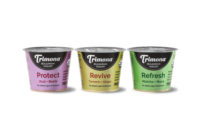On Jan. 1, 2020, the first stage of FDA’s mandated Nutrition Facts label change went into effect. Companies with $10 million in annual sales or more are now required to list added sugars on their products’ labels, and other brands will be required to follow suit by 2021.
It’s the latest phase in the changing perceptions around sugar reduction and health. While dieters of the past decades opted for reduced-fat or nonfat products, many now are looking for low-sugar options.
“According to ADM’s OutsideVoice consumer study, nearly 70% of consumers are concerned about the sugars and sweeteners used in the products they consume,” says Marissa Barnes, marketing director, sweeteners and fibers for Chicago-based ADM.
Westchester, Ill.-based Ingredion Incorporated also has studied consumer behaviors around sugar consumption, says Ivan Gonzales, marketing director, dairy for the company. It’s identified groups such as the “naturelles,” who want only nonartificial sweeteners, and the “sugar-frees,” who are okay with artificial substitutes.
“The insights tell us that the approach to addressing the challenge of ‘sugar reduction’ is dependent on the food or beverage and the corresponding target consumer,” Gonzales explains.
For example, yogurt processors who are looking to attract healthy eaters might have different sweetener needs than companies making indulgent — but lower in sugar — ice cream.
Christine Addington, senior dairy technical service specialist, Cargill, Minneapolis, agrees that what formulators look for in terms of sugar reduction varies. Fortunately, there are many options for sucrose substitutes — ranging from monk fruit to sugar alcohols to functional fibers. The key is finding the sweetener — or combination of sweeteners — that offers the flavor and functionality needed for a given product.
“Everyone would love to have a ‘magic bullet,’ a zero-calorie, label-friendly sweetener that tastes and functions exactly like a full-sugar version,” Addington notes. “The reality is that all sweeteners, caloric or not, taste slightly different from one another and have different functional attributes.”
Reduction challenges
Processors looking to reduce sugars will face challenges in reformulating their products without losing the look and feel that consumers love, says Kyle Krause, product manager, functional fiber and carbohydrates, North America for Parsippany, N.J.-headquartered Beneo Inc. Removing sugar from a food or beverage’s formulation affects more than its perceived sweetness level; it also impacts the overall taste perception, functionality and texture.
“Consumers want a better nutritional profile, but they don’t want to make sacrifices when it comes to the overall indulgent experience of good texture and great taste,” Krause adds.
The overall taste experience is something that processors should consider, says Ihab Bishay, Ph.D., senior director of sweeteners for Tokyo-based Ajinomoto.
“Many times, when you reduce sugar in a dairy application, you not only reduce sweetness but overall flavor impact,” he says. “In order to successfully reduce sugar, a formulator needs to overcome those challenges with quality clean-tasting solutions that maintain or even enhance the overall flavor and quality of the finished product.”
Beyond flavor impact, sugar alternatives sometimes add a bitter aftertaste to a formulation, says Monica Garces, market development manager, health and nutrition, Jungbunzlauer Inc., Des Plaines, Ill.
However, according to Addington, taste issues are one of the easiest obstacles for formulators to overcome when reducing sugar. She point to advances in stevia offerings — such as Cargill’s ViaTech stevia leaf extract and EverSweet stevia sweetener — that offer more balanced sweetness than first-generation stevia sweeteners.
“In contrast, addressing the texture challenges associated with reduced-sugar dairy can be more difficult,” she notes. “Consumers have set expectations on how dairy products should look and feel. Recreating that experience takes a combination of ingredient solutions.”
For example, in ice cream, sugar is an important component of texture and also impacts the formation of ice crystals. Additionally, it contributes to the slow-melt experience that consumers enjoy, explains Dirk Reif, technical director, high-potency sweeteners for ADM. Taking out sugar means that the freezing point will be impacted, among other issues.
Trevor Nichols, food scientist, Brenntag North America, Allentown, Pa., agrees.
“Sugar doesn’t only provide sweet taste; [it is] also responsible for texture as a whole, holding water and delaying ice crystal formation, as well as mouthfeel and viscosity.”
It’s not just ice cream that is affected by changes in sugar levels, however.
“Texture is equally important in yogurt, and sugar-reduction solutions need to consider the impact of pH and stability in a product that contains live and active cultures,” Reif says. “Dairy beverages will lose mouthfeel without sugar and require soluble solutions.”
Many sweetener suppliers have addressed textural challenges by introducing ingredient blends, part of which address sweetness and part of which address functional or structural concerns.
“The best nonsugar solutions come from combining high-intensity sweeteners such as stevia and sucralose with bulking sweeteners such as maltodextrin, allulose or erythritol,” Nichols says. “Natural fruit sweeteners like agave, coconut and maple, as well as honey, are also used as part of sweetener blends.”
Addington agrees that sweetener blends can help processors achieve their desired formulations.
“Recreating that [original] experience takes a combination of ingredient solutions,” she says. “For example, in ice cream, we often rely on ingredients like erythritol and chicory root fiber to replace sugar’s bulk, help with mouthfeel, provide freezing-point depression and minimize ice crystallization.”
Reif says ADM uses high-potency sweeteners such as stevia, monkfruit and sucralose, in combination with erythritol and/or allulose, which bring volume and mouthfeel.
“We achieve additional structure with tapioca starches, gums like xanthan and guar, soy lecithin and pectins, depending on the application,” he adds.
Naturally sweet
For processors that have addressed flavor and textural concerns, there’s yet another elephant in the room. Picking the right sweetener (or combination of sweeteners) also involves thinking through whether target consumers prefer natural sweeteners or are okay with artificial ones.
And the majority of today’s consumers read labels and are looking for products with short ingredient lists, says Barnes.
“Sixty percent of consumers say recognizable ingredients influence their purchase decision, and 66% say they are looking for labels with the shortest ingredient list,” she explains. “In 2020, these numbers are likely to rise, meaning successful reduced-sugar formulations must have shorter, more familiar ingredient lists that rely only on all-natural ingredient sources.”
Gonzales says he has noticed similar trends.
“With consumers paying closer attention to the labels and ingredients used to formulate their foods and beverages, product formulators are more careful on the selection of ingredients that they use to approach sugar-reduction needs,” he notes.
Fortunately, recent discoveries in the sweetener space mean that dairy processors have options in formulating “naturally sweetened” reduced-sugar products. One promising ingredient is allulose, a rare sugar that FDA recently determined would not count as an “added sugar” for nutrition-labeling purposes, as it is not metabolized by the body, explains Jim Carr, Ph.D., director, sweeteners global ingredient technology, Tate & Lyle, Hoffman Estates, Ill.
“Allulose is 70% as sweet as sucrose and has a sugar-like temporal profile and a sugar-like clean taste quality,” he adds. “Because it is a sugar, allulose delivers many of the functional benefits of sucrose, such as mouthfeel in fluid dairy products, a sugar-like taste profile in yogurts and creamy texture in texture in ice cream and other frozen desserts.”
Ingredion also introduced an allulose ingredient — Astraea — which Gonzales says tastes and functions very similarly to sugar and adds almost no calories.
“We have tested allulose in a number of applications, dairy among them, and it performs very well and improves several attributes to help make reduced-sugar dairy products more like full-sugar versions,” he notes.
DuPont, Wilmington, Del., also has seen success with allulose, says Chip Venables, one of the company’s dairy application scientists.
“Allulose is another emerging additive that is a low-molecular-weight carbohydrate [and] behaves a lot like fructose — however, without metabolic absorption,” he says. “Its use is limited to 5% solids in frozen dessert products, but it also can be an important component in formulating reduced-sugar products.”
Carr said Tate and Lyle’s allulose (offered under the name Dolcia Prima), along with its Tasteva M stevia sweeteners, provide dairy processors with natural sugar and calorie reduction and great taste.
“Tasteva M can achieve up to 100% sugar reduction in certain product applications and can provide a clean sugar-like taste without the bitter/licorice taste found in certain other stevia-based sweeteners,” he adds.
According to Andy Ohmes, global director of high-intensity sweeteners for Cargill, stevia is a good clean-label choice, as it already has a positive reputation among consumers.
“According to Cargill’s proprietary online research of 13,000 consumers, when compared to 12 of the leading low-/no-calorie sweeteners, consumers ranked stevia leaf extract as the most healthful, as well as having the most positive perception on the label,” he says.
For its part, Cargill invested more than 300,000 hours studying the stevia leaf to find the “optimal balance of sweetness and taste,” notes Ohmes. The result of this research are its EverSweet Reb M and Reb D sweeteners.
“They found that two glycosides in the stevia plant, Reb M and Reb D, offered heightened sweetness and a taste closer to real sugar,” he explains. “While these glycosides are rare in the stevia plant, Cargill produces them through fermentation. The result is a cost-efficient, great-tasting sweetener, produced with the environment in mind.”
Last year, ADM also launched a proprietary stevia solution called SweetRight Edge.
“This stevia leaf extract has a superior taste profile when compared to other steviol glycosides, and it’s a great option for dairy products where cleaner labels are desired,” says Barnes.
Non-sweetener solutions
There are ways to sweeten a product without using sweeteners at all. This includes formulation tricks such as using fibers or starches, which contain some sweetness along with functionality but do not add any sweeteners to the label, says Kay Abadee, director of marketing, Axiom, Chicago.
For example, Beneo offers Isomalt, a functional carbohydrate that doesn’t alter freezing-point depression, so it can replace sugar one-to-one in a frozen dessert formulation. The ingredient is 50% as sweet as sucrose, Krause explains. The company also offers chicory root fibers, which can help reduce sugar and calories, as well as “bridge the fiber gap.”
“A smart sugar reduction is replacing part of the sugar by enriching with chicory root fiber,” Krause says. “This means a lower glycemic response [to] the food, a higher fiber content, a prebiotic effect on the gut microbiome and weight management support by helping consumers eat less.”
And Axiom offers whole-grain dairy alternative ingredients that are made from rice and oats. These ingredients add to the sweet flavor profile and make it possible for fewer added sugars, says David Janow, the company’s CEO.
“That’s because we cannot digest grains without converting the starches into a sugar … and Axiom has essentially started the cooking/digestion process early,” he says. “With our AvenOlait and OryzOlait, we do create our own sweetness, but our bodies do, too.”
Krause said Beneo’s approach to sugar reduction includes considering physiology and metabolism, not just sugar numbers on a label.
“For manufacturers, the focus shouldn’t be solely on sugar reduction, but also on effective blood sugar management,” he explains. “Therefore, it’s key for manufacturers looking to reduce high-glycemic ingredients to focus on using carbohydrates that support balanced blood sugar levels and are low glycemic.”







